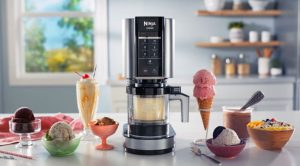Electric Grill: What Is It? How It Works, Applications, and Safe Usage Tips

An electric grill is a kitchen appliance designed to cook food by using electric heat rather than the traditional methods of using charcoal or gas. These grills are increasingly popular due to their convenience, safety, and ability to deliver a grilled taste without the hassle of outdoor setups. In this article, we will explore what an electric grill is, how it operates, its common applications, and how to use it safely to get the best results.
1. What Is an Electric Grill?
An electric grill is a cooking device that uses electricity to generate heat and cook food. It is often a more convenient and safer alternative to traditional grills that use charcoal or gas. Electric grills come in a variety of shapes and sizes, making them suitable for both indoor and outdoor cooking.
Types of Electric Grills:
- Indoor Electric Grills: These are designed for indoor use and often feature non-stick cooking surfaces. They are compact, easy to use, and ideal for apartments or homes without outdoor space. Some models come with a lid to control smoke and splatters.
- Outdoor Electric Grills: These larger models are built for outdoor use but still rely on electricity for heat. They are perfect for patios or small yards where traditional grilling methods might be impractical.
- Tabletop Electric Grills: Small, portable, and designed for tabletop use, these grills are ideal for cooking small meals or grilling in tight spaces. They are easy to store and take up less room in the kitchen.
- Contact Grills: Also known as panini presses or sandwich grills, contact grills feature two heating plates (top and bottom) that close around food. This design is perfect for grilling sandwiches, meats, and vegetables evenly and quickly.
Benefits of Electric Grills:
- Convenience: With no need for charcoal, gas, or open flames, electric grills offer a hassle-free cooking experience.
- Healthier Cooking: Many electric grills have non-stick surfaces and allow for fat and grease to drain away, resulting in lower-fat meals.
- Versatility: Electric grills can cook a wide range of foods, including meats, vegetables, seafood, and even fruit, making them versatile for various dishes.
- Indoor and Outdoor Use: Electric grills can be used both indoors and outdoors, making them suitable for different cooking environments.
2. How Does an Electric Grill Work?
Electric grills work by using electric heating elements to generate heat, which is then transferred to the cooking surface to cook the food. These grills are powered by electricity, making them more convenient than traditional grills that require a gas tank or charcoal.
Key Components of an Electric Grill:
- Heating Element: The heating element is the core component that generates heat in an electric grill. It is typically made of metal and is located beneath or inside the cooking surface.
- Cooking Surface: This is the part where food is placed to cook. Most electric grills feature a non-stick surface that makes it easier to clean and reduces the need for excess oil.
- Temperature Control: Electric grills usually have a thermostat or temperature control dial that allows you to adjust the heat according to the type of food you are cooking.
- Drip Tray: Many electric grills come with a drip tray to collect excess grease and juices from the food, ensuring healthier cooking and preventing messes.
- Lid (Optional): Some models come with a lid that helps trap heat and moisture, which can be useful for grilling thicker cuts of meat or keeping food warm.
The Cooking Process:
- Preheat the Grill: Start by turning on the electric grill and setting the desired temperature. Allow the grill to preheat for a few minutes to ensure it reaches the right cooking temperature.
- Prepare the Food: While the grill is preheating, prepare your food by seasoning or marinating as needed.
- Cook the Food: Place the food on the cooking surface and allow it to cook. Depending on the model, you may need to flip the food or close the grill to cook it on both sides evenly.
- Monitor the Cooking Process: Keep an eye on the food while it grills, adjusting the temperature as necessary. Many electric grills have built-in indicators to signal when the food is done.
- Serve and Clean: Once the food is cooked, remove it from the grill and clean the appliance to ensure longevity and hygiene.
3. Where Is an Electric Grill Used?
Electric grills are incredibly versatile and can be used in various settings, both for home and commercial cooking.
Home Use:
- Indoor Grilling: Electric grills are perfect for people who live in apartments, condos, or places with limited outdoor space. They allow you to grill indoors without the need for a balcony or patio.
- Easy to Use: Whether you’re grilling vegetables, meats, fish, or even fruit, electric grills are simple to operate and perfect for quick meals after a long day at work.
- Healthier Cooking: With the ability to drain excess fat, electric grills are great for making low-fat versions of your favorite grilled foods, such as burgers or chicken.
Outdoor Grilling:
- Patios and Small Yards: For those who prefer not to deal with charcoal or gas, outdoor electric grills are an excellent alternative. They provide a clean and efficient grilling experience, especially for small gatherings.
- Picnics or Camping: Portable electric grills can be used for picnics, camping trips, or outdoor events where access to traditional grilling methods is limited.
Commercial Use:
- Restaurants and Cafes: Electric grills are used in commercial kitchens for grilling a variety of foods quickly and efficiently, especially in establishments that want to reduce smoke and grease emissions.
4. How to Use an Electric Grill Safely
To get the best results and ensure safe operation, follow these guidelines when using an electric grill:
Before Use:
- Check the Power Cord and Plug: Ensure the power cord is intact and the plug is securely connected to a properly grounded electrical outlet.
- Position the Grill on a Stable Surface: Place the grill on a flat, heat-resistant surface to prevent accidents during use.
- Preheat the Grill: Always preheat the grill before placing food on it. This ensures even cooking and helps avoid sticking.
During Use:
- Avoid Overcrowding: Do not overcrowd the grill with food, as this can result in uneven cooking and potentially cause the grill to overheat.
- Monitor Cooking Time: Keep an eye on the food while it cooks, as electric grills may cook faster than traditional grills. Use a food thermometer to check for doneness, especially with meats.
- Keep the Grill Clean: Regularly wipe down the grill surface and the drip tray to prevent grease buildup and ensure optimal performance.
- Do Not Touch the Grill During Operation: Avoid touching the hot surfaces of the grill during operation, especially the heating elements. Use appropriate kitchen tools to handle hot food.
After Use:
- Turn Off and Unplug the Grill: After cooking, always turn off the grill and unplug it from the electrical socket to avoid any risk of electrical hazards.
- Clean Thoroughly: Allow the grill to cool down before cleaning it. Most electric grills have removable parts that can be washed separately.
- Store Properly: Store the electric grill in a cool, dry place to avoid any potential damage.
Conclusion
An electric grill is an excellent tool for anyone who enjoys grilling but prefers the convenience and safety of an electric-powered appliance. With various types available, from indoor models to portable outdoor grills, there’s a perfect option for everyone. By understanding how it works, knowing where and how to use it, and following safety guidelines, you can enjoy delicious, healthy grilled meals with ease. Whether you’re cooking indoors or outdoors, an electric grill offers the convenience of grilled food without the mess and complexity of traditional grilling methods.







